research portfolio
PORTFOLIO
Rui Calvo
I am deeply grateful to Lilia Mestre and the a.pass researchers who worked in front of my camera, being vulnerable, violent, playful, cheating, confused, confusing and much more: Andrea Zavala Folache, Caterina Mora, Diego Echegoyen, Federico Vladimir, Flávio Rodrigo, Lucia Palladino and Nathaniel Moore. I also thank my mentor, Sara Manente, who participated as a performer in two videos. They were all engaged in doing and thinking with me, each with a different background and contributing in a unique way. The trajectory the research has taken is also due to their collaboration.
I have a background in cinema and I came to a.pass in order to take a distance from this field. I wanted to think of the audiovisual narrative otherwise. My initial questions surrounded different ways of filming bodies while not imprisoning them in rational discourse. How to create characters that push these limits and reject the logic of belonging, of confirmation? The a.pass proposals and the reading of different texts throughout the trajectory produced new desires that led the research into an eternal conflict between theory and practice. My focus was on filming bodies, their faces, their gestures. Over the course of my research trajectory in a.pass, the constant practice of shooting people from the program who were interested in taking part in the videos, and editing the material gradually, brought new important questions to explore, but the initial one always remained there, always being transformed and gaining broader implications. I have allowed myself to make choices that may be considered naivety or failure, but they were important for discoveries and new paths. So in this portfolio I will present the proposition of each video I made in a.pass; the instructions given to the performers to work in front of the camera; the videos themselves; some notes of the discussions with curators, mentors and researchers about the practice; and quotes of books and texts I was reading – all according to my point of view in the present, while writing and most importantly, editing, as a way of thinking, filming, and rethinking the whole trajectory.
FIRST BLOCK: TROUBLED GARDENS
In the beginning of the block, I had in mind:
- The body is disciplined to mean something, to the detriment of the dimension of presence. So… Reject psychology. Empty the inner meanings of the gestures and impulses. Refuse to know the mechanics of choice.
- Acting: a process of self-exploration according to the statement above. It’s fun, playful, madcap… Lived experience as much a product of convention as dramatic experience.
- Masks > Personalities. Masks are used to adjust oneself to the situation, to the other people involved in it and also to the camera. Deal with masks.
- Physiognomy: an interest in guessing what meaning lies behind this person’s face; an idea of revealing. Need for a social control of the inner person.
- Facingness: observe faces and gestures inside a narrative without converting them into signs to reveal the inner psychology – preserve the opacity of this person.
- Audiovisual narrative where the bodies are not a translation into images of a screenplay and/or a discourse. The production of the character is unstable and influenced by the filming process itself. More interest in the process than the product, in the strength of an instant than in the logic of an action. Create forces that burst open both narrative and representation: the relationship between an image and an object that it should illustrate.
- Not a screenplay: preserve the natural language of the performers. No learning lines.
“Une notion comme celle d’identité, aujourd’hui entièrement policière (connotations psychologiques comprises, du ressort des redresseurs de moi en tous genres), recouvre bien un aspect de cette perte: le visage doit être identique, non au sujet, mais à sa définition. Il n’est plus la fenêtre de l’âme, mais une affiche, un slogan, une étiquette, un badge.” A notion like that of identity, today entirely policed (psychological implications included, the responsibility of all kinds of redressers of self) does contain an aspect of this loss: the face must be identical not to the subject but to its definition. It is no longer the window to the soul, but a poster, a slogan, a label, a badge. – JACQUES AUMONT
FIRST VIDEO (june 2019)
https://vimeo.com/501681981/b76441f773
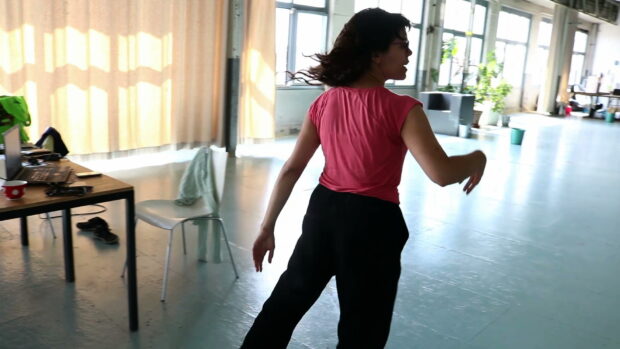
Shooting part I: frame Caterina’s body in wide shot. She is moving, dancing, rehearsing. An introduction to the next shot, creating a curiosity about her.

Shooting part II: Caterina’s face.
- practice my role behind the camera when I don’t have a script or a goal regarding content. What am I seeing through the camera in this context?
- practice a close relationship between the performer and the camera, or a dynamic of intersubjectivity between the cameraman and the model.
Instructions to Caterina:
- Silence. Don’t talk. Stay in the chair. You can look around, you are not supposed to stand still. Sometimes I want you to look at the camera, establish a relationship with it, as if it were someone else, a character.
- Staying in the chair, look for a spot in the room that catches your attention. Observe it and describe what you see.
Caterina’s feedback: “I was not super much thinking and I was just trying to be, like, calm. […] At first I was trying to be pretty and then I was a bit bored of myself… And… It’s not that I, I was thinking into something… I was just trying to focus on being here […] But I was trying to be calm. To not to do, so… but I think I did a lot. […] Or try to not have an opinion of what I was doing.”

Shooting part III: Flávio’s face. It was filmed later, without Caterina and it was less improvised, since I was planning the filming according to what happened in the previous shoot.
Instructions to Flávio:
- Silence. Don’t talk. Stay in the chair. You can look around, you are not supposed to be completely still. Sometimes I want you to look at the camera, establish a relationship with it, as if it were someone else, a character. I will not count the time, but you should stay like this for a few minutes. So, in your time, I won’t say anything, you look at the camera and say: “I’m gonna put a song” and then you get up and go left. When you return, talk to me but looking at the camera, I have questions for you. And you also must have questions for me. Do you think you are acting now?
Editing: connect Caterina’s and Flávio’s close-ups as if they were shot and countershot. Since they don’t interact and don’t talk about the same subjects, observe what their faces and gestures express in that mixture.
Video’s presentation feedback: Philippine Hoegen, one of the mentors of the block, sees a mixed relationship with the object, a game with it, in which there were no signifiers for Caterina. Surface x psychology. She says that the fact of framing implies a choice and immediately creates a relationship. Nicolas observes that a causality was created during editing, but not only that. A way of editing that controls and loses control, falls in love with faces. Caterina thinks I should be busy with clarifying the methodology of editing, and my role as an editor. It makes me think back to my interest in the strength of the instant over the logic of an action. How to play with this strength in the editing?
SECOND VIDEO (july 2019)
https://vimeo.com/500775699/6089a324a8
Unlike the first video, this one is about interaction between performers, and most of the time the camera is far away from them. The general situation of the scene is not clear, but each of them has two or three instructions to follow, a score in which they hover between fiction and being themselves – a creation of subjectivity through filming. None knows the instructions of the others. A score to ensure that the performers are not subordinate to the causality of narrative, that they surpass the limits of a given role and don’t reduce themselves to a character or an identity.
Instructions to the performers:
Flávio
. all the time you must be eating a fruit or talking
. you don’t want Diego in bed
Lilia
. read a book (Strangers to Ourselves or Sexus) that you find on the bed, sometimes aloud
. attentively observe Flávio and his body
. invite Diego to bed
. “Do you wanna go back to Brazil?”
Diego
. make questions about the couple Lilia and Flávio
. say many times: “I’m ok. Don’t worry.” “Do you want me to leave?”
. don’t look at them too much and when you look, disguise that you are looking
The close-ups are shot after the improvisation, a sort of interview in which I ask them questions related to subjects they were discussing in the shooting.
The improvisation is shot three times, alway restarting from the beginning, like in a rehearsal in which a scene is improved and a dramaturgy is created. But the aim is to create a score that allows people and relationships to be constantly in construction. To go further in this goal, the répétition (rehearsal and repetition in French) will be practiced in a different way in the following a.pass blocks, recording an ongoing situation that stops only when the shooting finishes (this subject will be explored later on).
The wide shot shows the space in its entirety, a recognizable space (a bedroom) that somehow situates the fictional situation. But it’s more a backdrop for a pursuit. Placing people together in bed is charged with meaning, and I want to see how they would deal with this without having a clear fictional framing.
Since the camera doesn’t get close to the performers, it doesn’t interfere much in the way they act. In some videos further on, I will hold it closer to them, making the intrusion of filming more noticeable, and opening the possibility for the performers to experience a different embodiment via the intersection of context and camera.

In this video, I don’t see a different temporality being created, nor a puncture (something that appears in the middle, between fiction and reality) or an awkwardness. Sometimes something close to this happens, like at 17:50 in the timeline of this video: Lilia says she feels more respected now that she’s getting older, then she covers herself with a blanket and talks about disappearing, not being framed. Her words cause discomfort in Flávio and Diego. There is a moment of silence in which they don’t know how to act. It’s an important quality in the development of the research, which I will go further with in the next videos.
During the video’s presentation in a.pass, Nicolas Galeazzi, curator of the block, observes that some instructions given to the performers have different qualities compared to others. For example, “all the time you must be eating a fruit or talking” produces something different to “you don’t want Diego in bed.” This is another practise I develop in the following block.
“Learning to be awkward, to be graceful, to leap, and to fall is a training in attention and also in revisceralizing one’s bodily intuition. It is a training that collapses getting hurt with making a life, but that includes the welcoming of exposure alongside of a dread of it. There can be no change in life without revisceralization. This involves all kinds of loss and transitional suspension.” – LAUREN BERLANT
“Which is preferable: changing my personality and keeping my body, or changing my body and keeping my current manner of experiencing reality? A fake dilemma. Our personalities arise from this very gap between body and reality.” – PAUL PRECIADO
“Contrary to the Lacanian theory of the mirror state, according to which the child’s subjectivity is formed when it recognizes itself for the first time in its specular image, political subjectivity emerges precisely when the subject does not recognize itself in its representation. It is fundamental not to recognize oneself. Derecognition, disidentification is a condition for the emergence of the political as the possibility of transforming reality.” – PAUL PRECIADO
“Perhaps Lingin suggests, rather than transmitting clear meanings, the encounter rests on an acknowledgment of an elemental otherness that is related to our own. ‘We don’t relate to the light, the earth, the air, and the warmth with our individual sensibility and sensuality’. We communicate to one another the light your eyes know…’” – AVIVAH GOTTLIEB ZORNBERG quoted by KAREN BARAD
“Living compassionately, sharing in the suffering of the other, does not require anything like complete understanding (and might, in fact, necessitate the disruption of this very yearning).” – KAREN BARAD
“Saying ‘the truth is a creation’ implies that the production of truth goes through a series of operations consisting in working a matter, a series of falsifications in the literal sense… each one is a falsifier of the other, each one understands in his own the notion proposed by the other. It is these powers of the false that will produce the true.” – GILLES DELEUZE
SECOND BLOCK: A LOOMING SCORE
One of the proposals of this block is a weekly meeting where each person presents 5 minutes of a practice, work, or something regarding their research, and about which another participant asks a question, and a third one answers on behalf of the first. Each asks and answers on the basis of his/her own research. I present videos that I shoot one day per week with performers and edit right after filming. Throughout this process, my questions from the previous block remain, but with new contours, and alongside new questions. The room where I film the videos is dark and not recognizable as a place: it’s not a living room, a bar, a rehearsal room, thus troubling the space where the performers can situate themselves (in fiction or reality). This creates the conditions for sub-narratives to arise and evolve. The instructions given to the performers have one or more of the characteristics listed below:
- that they stimulate repetition
- that they depend on personal interpretation according to their own feelings and opinions
- they don’t depend on personal interpretation, opinions, or feelings; the performers do it and right after have to process what was done: they are not protected by a character context
- that they demand attention to find the cue, a right moment to do it
- that they divert attention
- that they interfere in the flow of the action, of the narration
- that they activate an otherness (“Is it me who did it or not?”)
- that they demand the knitting of stories (the self does not produce fiction, but is instead produced by fiction); personal stories are mingled with tasks that move towards fiction
One new fundamental element of these videos is violence. There’s violence in the stories the performers are asked to tell, but none are told the instructions of the others, so there’s a tension of not knowing who has instructions that demand disrespect or aggression, nor what they might do with them (so they play a dynamic of glances). There is the violence of framing bodies, allowing the spectator to see what the performers see and also to watch the seeing, which the performers can’t. The cut in the editing becomes more prominent once the context (either real or fictional) is more unclear; every cut becomes an ellipse. The ellipse can be considered violent, but it can also be seen as a way of interfering in the moving image, freeing it from the surveilling eyes of the spectator.
Having to admit some aggression and to move within dissatisfaction (the inconvenience of other people), I ask them to not take the agressions too personally and to look for something in between the score and the improvisation. What kind of encounter is possible in such a context of tension, vulnerability, exposure to the other and to the camera, ongoing rupture, misunderstanding and indeterminacy? What kind of encounter is possible in a situation where the body has no stable response to an intention, because neither the filmmaker nor the performers have access to one? How much are these violent thoughts already embedded in the performers? If in the beginning of the research there was still an idea of character – though already unstable and influenced by the filming process itself – now this idea is even more troubled. What can be imagined in that scenario? What kind of alchemy is produced with those elements?
The instructions are given to the performers right before filming and, once I start shooting, I record uninterruptedly for one or two hours in the same space. So the actions, lines and stories contained in the instructions are repeated many times in an ongoing situation, creating a different temporality. The state of not knowing is prolonged. It’s a framed encounter in which improvisations are perpetually rearranged and rearticulated. The language spoken is mostly English, which none of us has as our mother tongue, and which therefore evolves as queered communication. This becomes an important element in my work within this context.
The video below is the final edit of all the videos I made throughout the looming score.
https://vimeo.com/496829852/95cb3f8106
Instructions for the visitors:
- watch the whole video before reading further
- then read the instructions for the performers
- remember that each video was originally shown without revealing the instructions to the spectators
- and that the whole series of looming videos were shot without the performers ever knowing each other’s instructions
Instructions for the performers:
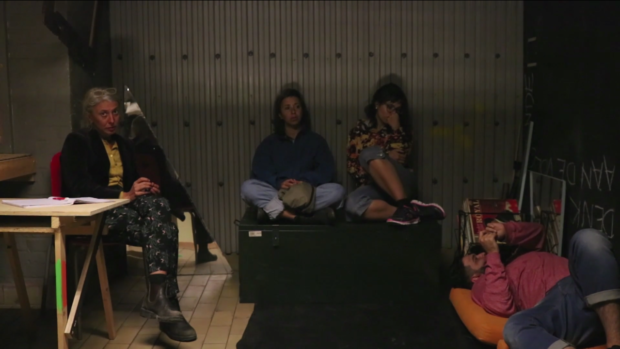
first part
everyone but Lilia
- you cannot be the first to say something.
Lilia
- first sentence you should say: “I realized that when you socially don’t notice the violence, it is because you do it.”
- take notes
Caterina
- what are the others hiding or showing/revealing?
- say “Stop that acting”
- always non-stop looking at the one who speaks
Flávio
- always start speaking using “I”
- hit the table to get attention or interrupt someone
Lucia
- repeat the sentence until it is understood or you are convinced that you were understood
- when someone says something, you stare at him/her for a while
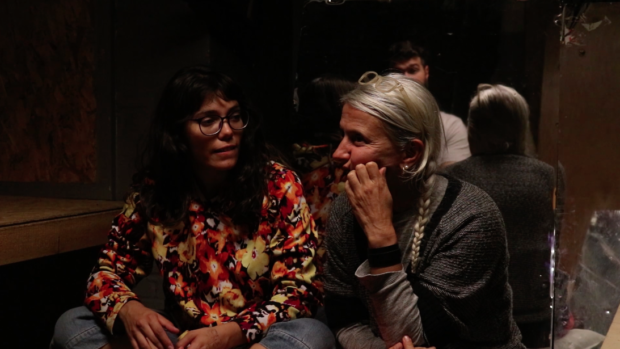
second part
Lilia
- tell again the train story you told in the first video, repeating it throughout the shooting, each time filling the story with more details
Caterina
- say to Flávio “Listen to her”
Flávio
- always start each sentence saying “I…”
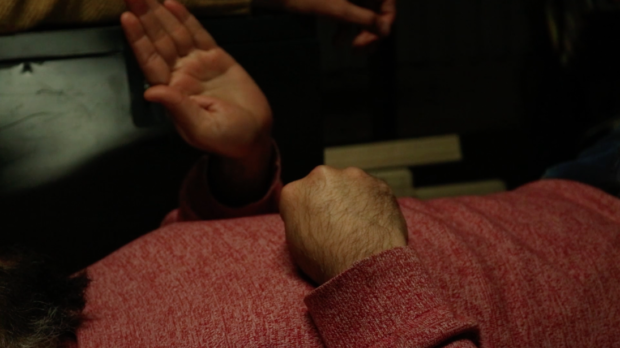
third part
Flávio
- tell Lilia’s story about the train as if it had happened to you
- do not move while speaking, only when you need to show an object or make a clear gesture while telling the story
Diego
- ask details about the story, always mixed with comments about the perception of Flávio in the present, his behavior, his gestures (e.g. What are you looking at? You’re warm. Your eyes are tiny. Your eyes change when you say [this word]).

forth part
Lucia
- tell the story about violence that you told in the first video, making only important gestures in order to explain it. Stay clear-eyed in the scene of violence, repeat the story giving more details, creating facts, trying to communicate.
Flávio
- describe the gestures and behavior of Lucia and imitate them
Diego
- ask about the other involved in Lucia’s story, imagining this role in the story
- play with a balloon
- ask Lucia many times: “Is it violent?”

fifth part
Caterina
- Tell Lilia’s train story as if it had happened to you
- Touch Lilia
- Repeat some of Lilia’s words
- Smile a lot
Lilia
- Say to Caterina that the story didn’t happened the way she’s telling it
- Ask Caterina to choose an insult against a woman and Lilia repeats it
- Describe people who pass on the streets and their behavior
The camera’s potential to interfere with the improvisation of the performers is not yet as incisive in these videos as it could be. Most of the time I am holding the camera far away and getting closer only by zooming in. In later videos, the camera, as well as my presence, will be more intrusive or at least there I will make attempts towards this. Jeroen Peeters, one of my mentors, participates in a filming practice as an observer and draws my attention to the question of whether I should be more present in the shooting. I think about my voice, my gestures (hors champ or not), the camera and my thoughts as possible agents of interference.* Jeroen also remarks on the private dramaturgy that is produced in each performer. I could also play more with my interference, allowing it to facilitate or threaten what is being produced.
* For me, it seems that “interference” is a concept that was always part of the research, but it was Lilia who drew my attention to it in a conversation in my last block.
“It is repetition that which ruins and degrades us, but it is repetition that which can save us and allow us to escape from the other repetition. Kierkegaard had already opposed a fettering, degrading repetition of the past to a repetition of faith, directed towards the future, which restored everything to us in a power which was not that of Good but of the absurd. To the eternal return as reproduction of something always already-accomplished, is opposed the eternal return as resurrection, a new gift of the new, of the possible.” – GILLES DELEUZE
“Tout l’effort du développement ‘technique’ du cinéma […] revient à naturaliser l’image cinématographique, c’est-à-dire à la domestiquer, à la familiariser […] Adieu à l’inquiétante étrangeté, adieu à l’altérité non récupérable, adieu au réel non encore cadrable.” The whole endeavour of ‘technical’ development in cinema […] comes back to naturalising the cinematographique image, meaning domesticating it, familiarising it […] Goodbye to troubling strangeness, goodbye to irretrievable otherness, goodbye to the as-yet-unframeable real. – JEAN-LOUIS COMMOLI
“The lack of elements to glue things creates an openness, a possibility of never settling. We cannot block out the irrationality, the perversity, the madness we fear, in the hopes of a more orderly world. […] Indeterminacy is not a lack, a loss, but an affirmation, a celebration of the plentitude of nothingness.” – KAREN BARAD
“Relationality always includes a scenic component, a fantasmatic staging.”
“Transforming the story of cause and effect to a spectacle of cause and side effects.” – LAUREN BELANT
“…identity allows us to distance ourselves from any actual manifestation of queerness”
“…accept the inauthencity at the core of something, understand it as a social institution, while still self-consciously and undeceivedly, succumbing to it.” – DAVID HALPERIN
THE IN-BETWEEN (BLOCK)
(an extra block to keep working on our research while having a lot of questions and a myriad of uncertain responses in self-confinement)
https://vimeo.com/502113573/783aa7dbda
https://vimeo.com/499227081/7b346852c7
https://vimeo.com/499345273/0150a29bd1
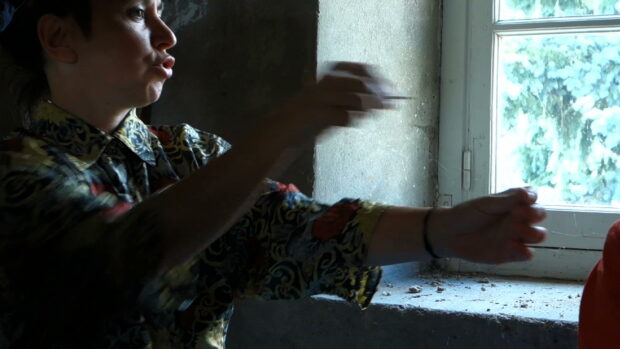
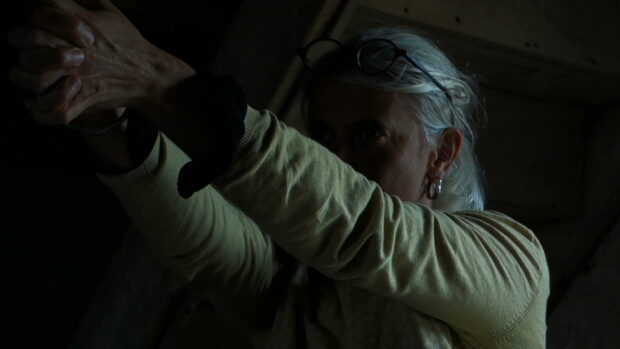
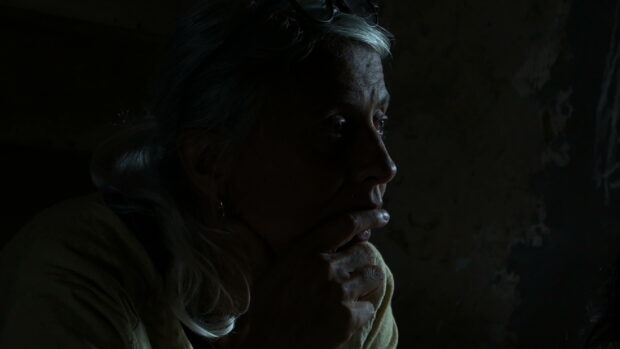

“Lies are so hard to keep track of. It’s like you’re constantly being reborn every time you begin a new sentence.” – DENNIS COOPER
“L’art de vivre, c’est de tuer la psychologie, de créer avec soi-même et avec les autres des individualités, des êtres, des relations, des qualités qui soient innomés.” The art of living is to kill psychology, to create with oneself and with others unnamed individualities, beings, relations, qualities. – MICHEL FOUCAULT
“Ideia de identidade só funciona quando a subjetividade está reduzida ao sujeito”. The idea of identity only works when subjectivity is reduced to the subject. – SUELY ROLNIK
“Shame is the affect that mantles the threshold between introversion and extroversion, between absorption and theatricality, between performativity and — performativity.” – EVE KOSOFSKY SEDGWICK
FOURTH BLOCK: SETTLEMENT
The aim of the Settlement workshop is “to create a poly-central gathering that is self-structured, self-organized and open to contributions from anyone. You are cordially invited to join this process by establishing your own space in the a.pass Settlement and sharing some of your ideas, practices or works with others. The materials and structures available at the a.pass main space will be a common resource for all who join to create whatever is needed to facilitate this process.” Trying to adapt my research to this proposal, I work on making a set for my filming practice. A nondescript space, a potential landscape that doesn’t represent a specific place but whose elements engender different connotations according to the acting of the performers and how I choose frame (dark spots, a red curtain, a corridor).


The following video is shot in that space, mixing up a private and intimate sphere with a theatrical scene. Although the performers discuss the news, tell personal stories and perform violent gestures, there is no predetermined discourse. The aim is to have no project, to preserve a way of filming that is a form of thinking in real time, to create the conditions for something to emerge, to articulate new meanings or to dislocate the subject of meaning altogether. In this shoot, the performers acknowledge the camera and the viewer’s presence more, resulting in uncomfortable physical responses to the act of being filmed and encaged, or to the feeling of being “unmasked.”


My work with the camera and the editing opens a negotiation between what I watch, what I feel about it, what I would like to produce. There are moments that flow in their whole duration (“real time”) and other ones that I cut more, creating a cumulative effect of time.
https://vimeo.com/501671946/2d2e19e6f1
Some extracts from the interview with the performers of the video above (Andrea Zavala Folache, Caterina Mora, Lilia Mestre) about their experience and Kasia Tórz as a mediator. The transcription is faithful to the syntax of the speakers.
RC: How would you define the agency you had?
LM: …is about interfering, possibility of interfering. Dislocating as well what’s happening. And also […] to not do, you can stop anytime. […] it’s not sequential instruction in a way. I think interference is the best word. Which is a generator.
[…]
I think we are on standby and then things start to happen. There’s quite some rupture […] It doesn’t need to be violent […] but to cut through.
KT: Andrea, do you also share this notion of interfering?
AZF: Yes, in the sense of… I thought the agency I was given or I was taken was one with autonomy, like that the agency was autonomous to… to be responsible of when to interfere or change track of things or when to enable the score or disable it. It makes me think also of interdependence, so interfering as a sort of… that this fear that creates the action where the three of us are agents, is one that is interconnected. So it’s an interdependent relationship of… I have my autonomy but it doesn’t take away the responsibility to actually, anything I do can be changing how things will resolve themselves or get lost.
CM: So for me about interference, I don’t feel it more in terms of the dramaturgy because I feel more the continuation actually, the repetition of the rule. And when I see interference is more in terms of the rhythm, so something in the rhythm of what’s happening is being cut but something that appears. But for me the agency is more related to how much can I push the rule, how much the rule resists. My agency is kind of being as obedient as possible.
RC: How much agency you have? Is it something you can play with or… are you in a trap? Does vulnerability allow boundaries to be open or the opposite?
LM: The instructions are my guidelines to interfere. […] I do feel trapped but not badly. It also feels like “Ok, this is what you can do”, so it’s also relaxing to know that “ok, this is what you can do”. It’s not a trap in a negative way, like finding our way out of there. But I feel that the conditions are well established, I can’t… I’m well situated. Maybe the environment defines very much where you are and how you can move within that space.
[…]
In terms of vulnerability, I do feel vulnerable… There’s nothing bad. I never felt bad. Neither to feel trapped. Neither to feel vulnerable. Neither to interfere. So there’s something there supporting these actions or these qualities that you are naming. So I also feel confident that I can feel vulnerable. Sometimes I think it’s needed somehow so I’ll work for that, to try to be in that place of vulnerability. This is my own thing.
KS: Have you ever questioned the instructions or had a desire to add something or to cheat a bit?
AZF: For me, the cheating is totally inscribed in the rules somehow. I am given enough information to know I can’t know all the rules… So there’s an impossibility for me to know everything, you know, to hold all the information of the rules. So then there’s gaps of interpretation that opens up a… Maybe that’s also for the agency, a sense of being able to interpret and cheat. But I think when I was performing… It’s kind of actually hard to cheat because the rules are not so many so there’s a lot of space to do many other things… so the rules imply that not everything that I would do it’s a rule or something the director has told me to, so then all those other things are they cheating? So to cheat I guess would be to not obey the rule so even that it’s impossible. I mean unless we have a long conversation about exactly how my interpretation can follow a rule, but so I feel like it’s a sort of puzzle that I enter. […] And the fact that I’m giving the information to have enough knowledge that it is a puzzle, then I feel a lot of trust from both Lilia and Caterina, and from Rui. And then the vulnerability can actually be embraced in a way. I like to think that vulnerability doesn’t contradict confidence. That in order to be vulnerable, especially in performing, you need confidence to actually be vulnerable for something. So that trust for me is really key. You know, that you trust my interpretations, my cheating, my following the rules, all of this is part of the puzzle. And I don’t feel totally trapped in it but I understand that walls are needed somehow.
RC: The instructions allow cruel actions, but these violences are not often followed by a reaction (no punishment, no confrontation, no resolution). Do you feel surprised by some of the actions of the others and how do you deal with it?
LM: Instructions are not much given of how to react but more how to propose. (…) In relation to the one when Andrea calls me cunt, that was hard actually. I mean it was difficult to… And then it was very interesting to see how I could somehow compensate that humiliation somehow, right? How can I reunite myself again as a character? So it’s a moment of being disarmed, you’re like “ok”, and then how do I build it up, how do I create some consistency that I don’t collapse. How to rebuild to be able to play, to be able to be there.
AZF: I also felt that when I called Lilia a cunt, the violence was in realizing that I would not do that in my life. So what am I saying “yes” to here?. Like am I doing it for the sake of art or a friend? So the fiction of the apparatus sort of save the violence but there’s still an ethical question in me of how far do I go for art. Because if I would be an actress following a script, people would know I’m a character. So it’s sort of excused in a way. And here because part of the script is taken out or something, it’s almost like I’m playing Andrea so I am close to reality. So people don’t know how I am playing with fiction actually, so the fictions that I play for myself are not totally visible. Then that kind of unappointed fiction or undefined fiction is what is the most violent of the work. But at the same time there’s still a part of fiction so I don’t feel extreme, not actually that it is causing any deep trouble.
CM: It often happens I’m kind of surprised in my interior. And then it’s a bit shocking because… the camera is there not far away… Depending on how this surprise is, I’m also trying to integrate it. […] A lot of things are happening because I’m always producing in relation to how I feel, to this surprise… And how I deal with this surprise.
LM: I was thinking about our relationship outside of the camera, the situation. So I mean the level of complicity or friendship that we have already between us and… How does this play within when we are playing? Because we are all doing indeed ourselves and we are all part of this program, so we carry something with us already in the projection of who we are towards each other, so there’s another score in there also. There’s a system of relations that it’s there. If we were foreigners to each other it would be another one. Here we have a degree of knowledge of each other that comes from a.pass. We are all very much foreigners, we all come from different parts of the world with different stories. So we carry that and then we carry some common ground within the program and then we go inside that room.
CM: The most violent is the editing, when I see how it’s also then afterward manipulated.
LM: Always something can turn, the things can turn around, into another direction. In this sense there’s a bit of maybe immanent violence, there’s a sense of this quietness. It can be fun… I always feel a certain tension there where things could turn. I put some violence there. (…) Like, something can come from the back, something can come from a place that you didn’t… So maybe this is because we know that the instructions are different and then we don’t know them, so there is an alertness in a way.
RC: Each instruction has a different quality in the repetition. What does it do? It’s a skill-development instead of character-development?
LM: I think that’s very hard actually, to repeat. Spontaneous is maybe more “ok”, you just throw yourself, let’s try this. But then repeat that you have to think twice. And then I think in a way it’s there where the work starts. Like how do you say it, and then maybe sometimes you just say it halfway… This is one thing, there’s a lot of practice in there. I feel the most acting practice comes from that place actually, of how to repeat things. And then I also think It creates a certain intimacy. […] maybe not intimacy but history. Like I’ve been there before. I have heard it before. I’ve heard you say that before. I’m not telling that story myself. There is something that builds like a common history. Like the story of the train that it’s there since the beginning, now Andrea also knows that story but she doesn’t know exactly where it started, how it was originally. This story became something that we all know collectively and we all have different relations to that thing. […] You don’t know anymore if it was real not real, how and what happened actually, but somehow you have an idea of that story.
CM: [repetition] creates a condition that escapes, it’s escaping from the succeeds and failures, another condition of doing it. It doesn’t have to succeed because it doesn’t have to fail. […] It creates a condition to navigate in all […] What I like from repetition is that all the time it pushes me in the same position of doing something I don’t know if I would do it in a situation.
AZF: For me is also a concrete form of awkwardness, that I value a lot as well. It’s kind of like being “hey, how are you?”, “hey, how are you?”, “hey, how are you?”. Like if you just give yourself whatever word and then you repeat it, it becomes absurd as well. Or everytime you say, there’s no training of it, other than saying it, so the intention changes so it’s awkward to say it again without knowing what’s the difference in the intention […] If all I have to do is say a line and I have to rehearse it, but now I can’t rehearse but I have to repeat it, so it becomes more and more awkward for myself.
LM: For example, in the laughter, it’s an interesting one. To have to laugh. Because I feel definitely awkward because there’s no reason, right. But then at the same time I have to say it was like listen to yourself, I know what a laugh can be, a real laugh. There’s also the question of the real laugh. Can I really do it for real?
CM: All the time it allows displacement, the repetition.
RC: And the role of the camera?
AZF: It’s like a level of being hyper aware, of self-awareness, alertness maybe, surveillance. I don’t think I forgot at any point that there was a camera.
KT: Did you enjoy it also?
AZF: Yeah. I guess that’s the creepiness of exposure and performance. It’s pervert. (…) I think I got at some point reminded that my agency has the right to challenge you as well and the camera. And I am so hyper aware of where it is that at any point I could just do this:

[Andrea is the one in the lower left]
LM: I think it happens more when you [Rui] are inside, in the beginning you were not inside. It was much more disarming because you don’t know at all, you just have the camera away with everything and you don’t know if it’s coming closer or further, so you are much more disarmed. Once you are there then… cause there’s also the possibility of getting away from the camera. You can also leave. You can also go. And in a way I think it becomes a character, there’s also Rui there. It’s also intrusive in a way, like “I’m looking at this, I’m interested in that”.
RC: But it’s less voyeur?
LM: Yes. I think it’s less voyeur.
